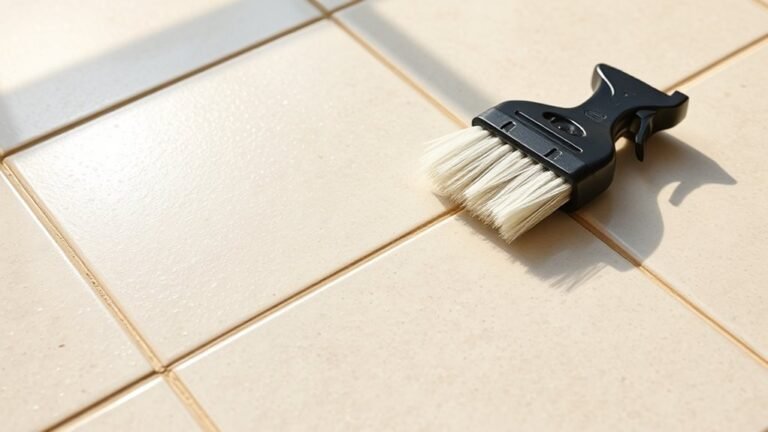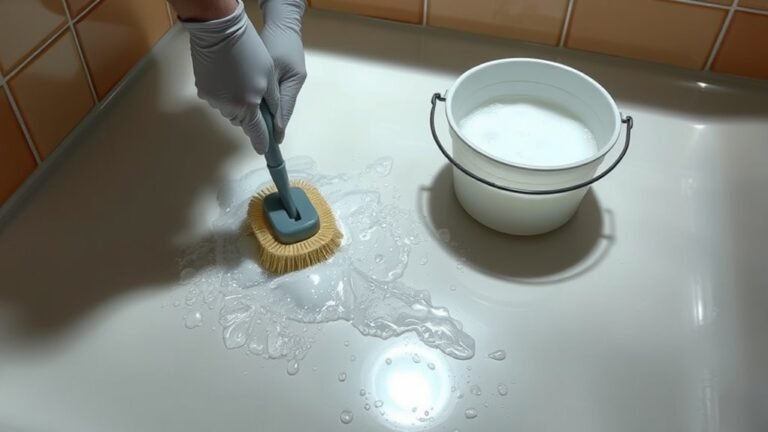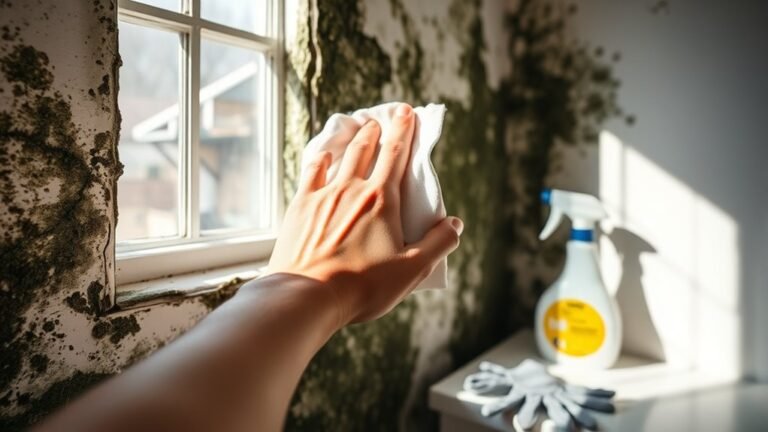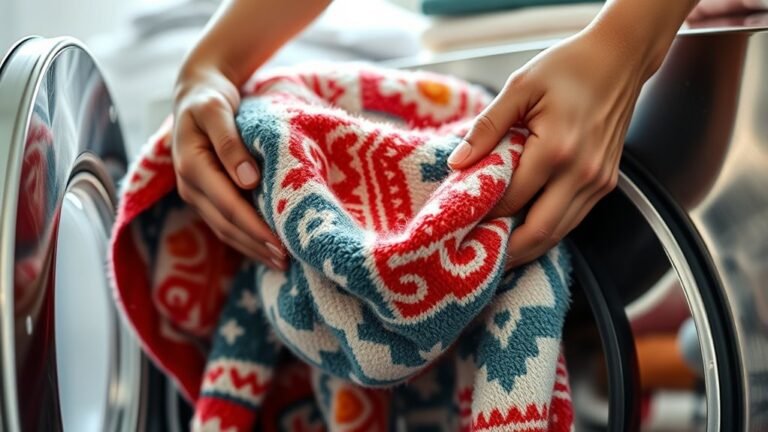How to Remove Hair Dye Stains From Bathroom Surfaces
If you’ve got hair dye stains on your bathroom surfaces, act fast and use gentle, surface-safe cleaners like baking soda paste or a vinegar-water mix. For ceramic tiles, scrub with a soft brush; on countertops, blot and use mild soap. Porous surfaces need extra care to avoid damage. Always wear gloves and test cleaners on a small spot first. With the right steps and some prevention tips, you can keep your bathroom looking fresh and stain-free—there’s plenty more to discover.
Identifying Different Types of Bathroom Surfaces

Before you tackle hair dye stains, it’s important to know what kind of bathroom surfaces you’re dealing with. Different surface types—like ceramic tile, porcelain, glass, or laminate—each have unique surface stain characteristics that affect how stains set and how you should clean them. Porous surfaces, such as natural stone, tend to absorb dye quickly, making stains tougher to remove. Non-porous surfaces like glass or glazed tiles usually hold stains on the surface, which means you can wipe them away more easily. Understanding these differences gives you the freedom to choose the right approach, avoiding damage while effectively removing those stubborn hair dye spots. Recognizing your bathroom’s surface type is the first step toward a cleaner, stain-free space without hassle.
Preparing Your Cleaning Supplies
Before you start cleaning, make sure you have the right tools like sponges, cloths, and brushes ready. Choose cleaning agents that are safe for your bathroom surfaces to avoid damage. Don’t forget to wear gloves and protective gear to keep your skin safe from harsh chemicals.
Essential Cleaning Tools
Gathering the right cleaning tools is essential to effectively remove hair dye stains. Start by grabbing sturdy cleaning brushes that can reach into corners and grout lines without scratching surfaces. These brushes help you tackle stubborn dye residues with ease. Next, have microfiber cloths on hand—they’re excellent for wiping away loosened stains and absorbing excess moisture without leaving lint behind. Make sure your cloths are clean to avoid spreading the stain further. With these tools ready, you’ll have the freedom to clean efficiently and confidently. Avoid using rough sponges or abrasive pads that might damage your bathroom surfaces. By choosing the right cleaning brushes and microfiber cloths, you set a solid foundation for a successful stain removal process that keeps your space looking fresh and dye-free.
Choosing Safe Cleaning Agents
Once you have your cleaning tools ready, the next step is picking the right cleaning agents to tackle hair dye stains safely. You want effective solutions without compromising your freedom to live chemical-free or damage your bathroom surfaces. Here’s how to choose wisely:
- Opt for eco friendly options like white vinegar or baking soda—they’re gentle yet powerful.
- Avoid harsh chemicals that can cause skin irritation or damage surfaces.
- Check labels for chemical safety; steer clear of ammonia or bleach if you want a safer clean.
- Consider specialized stain removers designed for hair dye, but prioritize those with natural ingredients.
Preparing Protective Gear
While tackling hair dye stains, you’ll want to protect yourself and your surroundings by preparing the right gear. Start by slipping on protective gloves to shield your skin from harsh chemicals and dye residues. Gloves give you the freedom to clean confidently without worrying about irritation or staining. Next, put on a face mask to avoid inhaling any fumes from your cleaning agents. This simple step keeps your respiratory system safe and helps you breathe easy as you work. Make sure your work area is well-ventilated, too. Having these essentials ready not only safeguards your health but also lets you focus fully on removing those stubborn stains. With protective gloves and a face mask, you’re set to clean efficiently and freely.
Removing Hair Dye From Ceramic Tiles
If you’ve got hair dye on your ceramic tiles, acting quickly is key to preventing permanent stains. You’ll want to use effective cleaning solutions like baking soda or rubbing alcohol, paired with gentle scrubbing techniques. Let’s explore the best methods to restore your tiles without causing damage.
Effective Cleaning Solutions
Cleaning hair dye from ceramic tiles can seem challenging, but you can tackle it effectively with the right solutions. Choosing eco friendly cleaners not only protects your surfaces but also supports a healthier environment. Here are four effective options to evaluate:
- Baking soda paste – Mix with water for a gentle, natural scrub.
- White vinegar – Works well for breaking down dye stains without harsh chemicals.
- Hydrogen peroxide – Use for tougher stains, but test on a small area first.
- Mild dish soap – Combine with warm water for everyday cleaning power.
These solutions offer freedom from harsh toxins and align with your desire for eco friendly stain removal techniques, making your bathroom sparkle without compromise.
Stain Removal Techniques
Three simple stain removal techniques can help you get hair dye off ceramic tiles without damaging the surface. First, apply a paste of baking soda and water directly to the stain, gently scrubbing with a soft brush to lift color without harsh abrasion. Second, try rubbing alcohol on a cloth to break down the dye; this method supports effective stain prevention by catching spills early. Finally, use a diluted hydrogen peroxide solution for stubborn spots, but test it on a hidden area first to avoid color fading of the tiles. Act quickly to prevent stains from setting, preserving your freedom to enjoy a clean bathroom without harsh chemicals or permanent marks. With these techniques, you can confidently restore your tiles’ original look.
Cleaning Hair Dye Off Bathroom Countertops

Bathroom countertops are often the first place hair dye stains show up, but you don’t have to worry—removing them is usually straightforward. When you spot hair dye on your countertop, quick action is key to protect your surface and maintain countertop care.
Here’s how to clean hair dye off bathroom countertops:
- Blot the stain gently with a damp cloth to avoid spreading.
- Apply a mild cleaning solution like dish soap mixed with water.
- Use a soft sponge to scrub the stain lightly, avoiding abrasive materials.
- Rinse the area with clean water and dry with a soft towel.
Following these steps lets you regain freedom from stains without damaging your countertop’s finish.
Getting Hair Dye Stains Out of Porcelain Sinks
If you spot hair dye stains in your porcelain sink, it’s best to act quickly before they set. Using gentle, safe cleaning solutions can help remove the color without damaging the surface. To keep your sink looking fresh, you’ll also want to take steps that prevent future stains from sticking around.
Immediate Stain Treatment
Although hair dye stains can seem stubborn, acting quickly is key to preventing permanent marks on your porcelain sink. Immediate action helps prevent deep stain absorption, making removal much easier. Here’s how you can tackle it right away:
- Blot the stain gently with a clean, dry cloth—don’t rub, or you’ll spread it.
- Rinse the area with cool water to dilute the dye and stop it from setting.
- Use a damp cloth to absorb as much dye as possible—repeating this helps lift the stain.
- Avoid letting the dye dry; keep the area moist until you can apply a proper cleaner.
Safe Cleaning Solutions
When dealing with hair dye stains on your porcelain sink, choosing safe cleaning solutions is essential to avoid damaging the surface. You want to keep your bathroom looking fresh without harsh chemicals eating away the glaze. Eco friendly solutions like a paste made from baking soda and water work wonders. Simply apply the paste to the stain, let it sit for 10 minutes, then gently scrub with a soft cloth. Another great homemade cleaner is a mixture of white vinegar and dish soap diluted in water—spray it on, wait a few minutes, then rinse. These gentle options effectively lift dye without risking scratches or discoloration. Using safe, natural cleaners not only protects your sink but aligns with your freedom to live toxin-free and keep your space healthy.
Preventing Future Stains
Using gentle cleaners is a great start, but preventing hair dye stains from settling in your porcelain sink saves you time and effort down the line. You want freedom from constant scrubbing, so consider these smart steps:
- Apply protective coverings like plastic wrap or old towels around the sink before dyeing.
- Choose products designed for stain resistant surfaces to minimize absorption.
- Rinse the sink immediately after dyeing to prevent dye from bonding.
- Keep a small cleaning kit nearby for quick spot treatments.
Eliminating Dye From Acrylic Bathtubs
Since acrylic bathtubs are prone to staining from hair dye, it’s important to act quickly to prevent permanent marks. You want to keep your acrylic care routine simple while maximizing stain prevention. Start by blotting the stain gently—don’t scrub, as acrylic can scratch easily. Use a mild cleaner designed for acrylic surfaces or a diluted dish soap solution.
| Step | Action |
|---|---|
| 1 | Blot excess dye immediately |
| 2 | Apply mild acrylic-safe cleaner |
| 3 | Let sit for 5 minutes |
| 4 | Gently wipe with soft cloth |
| 5 | Rinse and dry thoroughly |
Quick action protects your freedom from stubborn stains, letting you enjoy your space without worry.
Using Natural Remedies for Dye Stains

Although chemical cleaners can be effective, you might prefer natural remedies to tackle hair dye stains, especially if you want safer, eco-friendly options. Natural stain removers offer a gentle yet powerful way to regain your bathroom’s fresh look without harsh chemicals. Here are four easy methods you can try:
- Vinegar solution – Mix equal parts white vinegar and water, apply to the stain, let sit, then scrub gently.
- Baking soda paste – Combine baking soda with water, spread on the stain, and scrub lightly.
- Lemon juice – Apply fresh lemon juice directly to the stain; its natural acidity helps break down dye.
- Hydrogen peroxide – Use sparingly on tough stains as a natural bleaching agent.
These natural stain removers empower you to clean freely and responsibly.
Applying Commercial Stain Removers Safely
Natural remedies are great for gentle cleaning, but sometimes you need a stronger solution to tackle stubborn hair dye stains. That’s when commercial stain removers come into play, offering powerful commercial stain effectiveness to break down tough pigments. Before you jump in, be certain to follow safety precautions: wear gloves, guarantee good ventilation, and test the product on a small, hidden area first. These steps protect your skin and surfaces while maximizing results. Applying the remover carefully lets you reclaim your bathroom’s clean look without damage. Remember, using these products responsibly gives you the freedom to handle even the most stubborn stains confidently and efficiently, restoring your space without worry.
Preventing Future Hair Dye Stains in the Bathroom
To keep your bathroom free from hair dye stains, you’ll want to take a few simple preventive steps before you start coloring. Being proactive with preventive measures lets you enjoy your styling freedom without worrying about messes. Consider the following:
- Install or upgrade to stain resistant surfaces like quartz or sealed tiles to minimize absorption.
- Use protective coverings such as old towels or plastic sheets on counters and sinks.
- Keep cleaning supplies handy to address any accidental spills immediately.
- Designate a specific area for dyeing hair that’s easy to clean and away from porous materials.
Tips for Quick Cleanup During Hair Dyeing Sessions
Whenever you’re in the middle of a hair dye session, quick cleanup can save you from stubborn stains later on. Keep a damp cloth or baby wipes handy to immediately wipe off any dye drips or splashes on sinks, counters, or faucets. During dye application, try to work slowly and deliberately to minimize spills. Wearing gloves and using a cape or towel around your shoulders can prevent dye from staining your skin and clothes. If you notice dye on your hands or surfaces, don’t wait—address it right away with a gentle cleaner or makeup remover. Taking these small steps gives you the freedom to enjoy your hair transformation without worrying about permanent messes, making the whole dyeing process smoother and less stressful.
Frequently Asked Questions
Can Hair Dye Stains Cause Permanent Damage to Bathroom Grout?
Yes, hair dye stains can cause permanent damage to your bathroom grout if you don’t act quickly. Grout is porous, so the dye can seep in and become tough to remove. To avoid this, focus on grout cleaning right after any spills and practice stain prevention by wiping up dye immediately. By staying on top of it, you’ll keep your grout looking fresh and maintain your bathroom’s freedom from stubborn stains.
How Long Should You Wait Before Trying to Remove Fresh Hair Dye?
You shouldn’t wait long before tackling hair dye removal—acting quickly is key to stain prevention. The fresher the stain, the easier it’ll be to clean up, so try to start within 5 to 10 minutes after the dye spills. Don’t let it sit and set; prompt attention gives you the best shot at freedom from stubborn marks. Grab your cleaning supplies and go for it right away!
Are There Specific Hair Dye Brands That Are Less Likely to Stain Surfaces?
Did you know that over 60% of hair dye users report stains on surfaces? When it comes to specific brands, you’ll find some formulated with lower color deposit, making stain prevention easier. Brands advertising gentle formulas or semi-permanent dyes often reduce the risk of stubborn stains. If you want freedom from constant cleanup, choosing these options lets you enjoy vibrant hair without worrying about ruining your bathroom surfaces.
What Should You Do if Hair Dye Stains Your Bathroom Mirror?
If hair dye stains your bathroom mirror, don’t stress. Start with a gentle mirror cleaning spray or a mix of vinegar and water to loosen the stain. Use a soft cloth to wipe away the dye carefully, avoiding scratches. For stubborn spots, try a bit of rubbing alcohol. To keep your freedom from future messes, practice stain prevention by covering surfaces before dyeing and cleaning spills immediately. You’ve got this!
Can Hair Dye Stains Be Removed Using Household Bleach Safely?
You might worry bleach will damage surfaces, but with bleach safety in mind, it can be effective for stain removal. Just make sure you’re in a well-ventilated area and wear gloves to protect your skin. Test a small hidden spot first to avoid any unwanted damage. Bleach can lighten hair dye stains, but don’t leave it on too long. This way, you get the freedom to clean without ruining your bathroom surfaces.






